Archtiecture Is When a Building Looks Better Than the Art Inside
36 incredible famous buildings to inspire yous

The world's about famous buildings can be a huge source of inspiration for artists and designers. Structural shapes, unique pattern concepts and decorative details can provide ideas for design projects of all kinds. A building too tells u.s. a lot about a land's culture and way of life during the flow it was congenital. It's a fleck like looking at a historical photograph, only unlike in a photo, buildings evolve later construction has finished.
Time affects a building's aesthetic, equally renovation responds to wear and tear, but as well to changing tastes. Nosotros've picked some most incredible famous buildings to marvel at. Admire them from the screen, or you might want to depict upwardly a wish list for places to visit as international travel starts up over again, in which case y'all'll desire to get the best camera for creatives or to beginning looking at sketching tips to capture what you meet.
36 incredible famous buildings to inspire y'all
01. Beijing Daxing International Airport
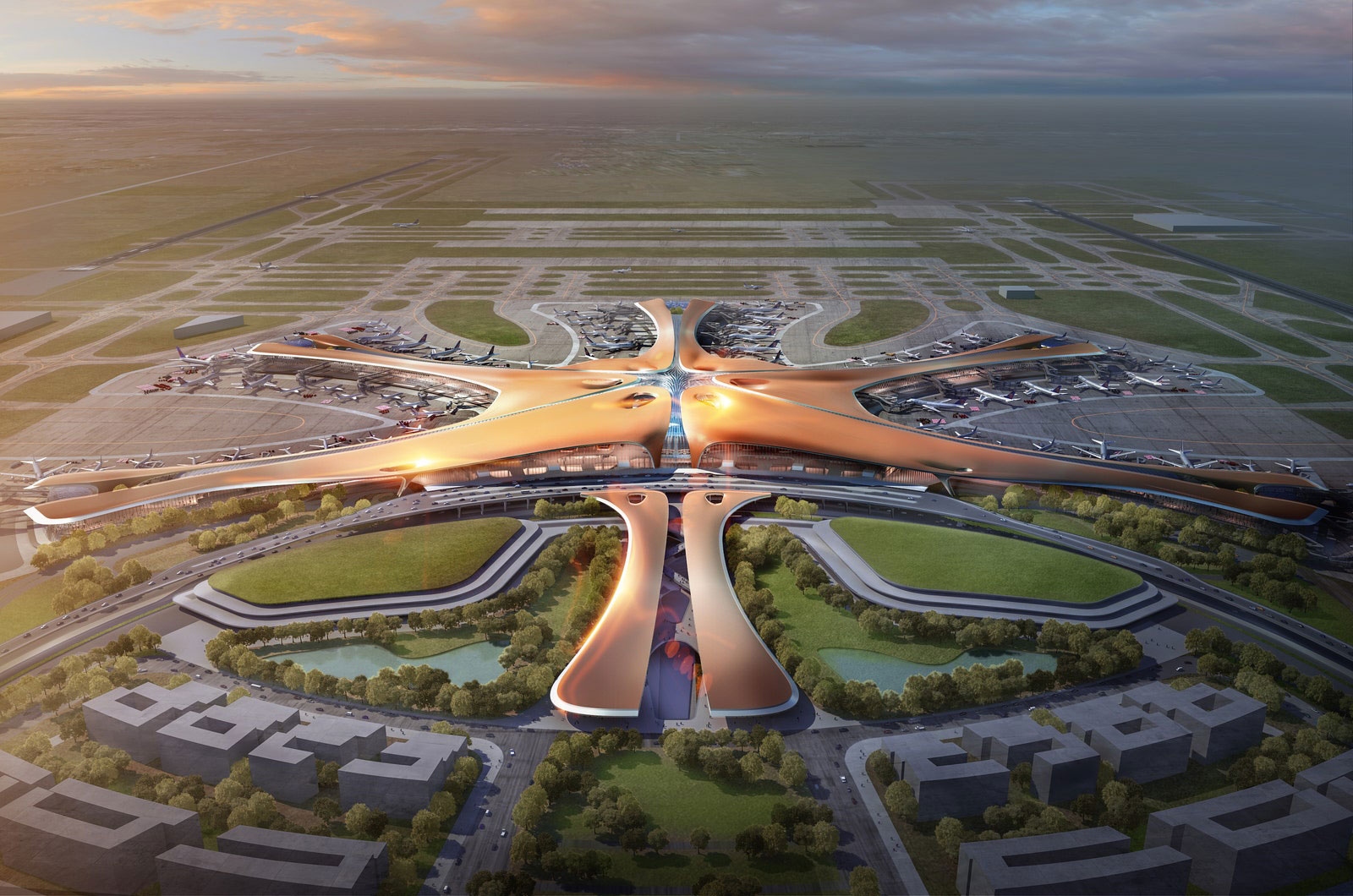
A relatively new construction, Beijing's 2d international airport replaced Istanbul as the world's largest when it was completed in 2019. Known as 'the starfish', it's sprawling star shape spans 7.5 meg foursquare feet. Designed past Zaha Hadid Architects before Hadid'due south decease, it non only looks incredible, but it'south uber-practical equally well, with an innovative layout designed to make things easier for travellers. This is edifice design that'south both functional and stunning to behold.
02. Guggenheim Museum Bilbao
Designed by Frank Gehry, the Guggenheim Bilbao Museum was completed in 1997. Information technology'south a mass of smooth curved lines and glittering tiles. The museum is crossed at i end by a bridge, which is crowned by a large skylight in the shape of a metallic flower. The design is so complex that Gehry used advanced software originally conceived for the aerospace industry to work on the design. You can learn more about the edifice's architecture here.
03. Sagrada Familia, Barcelona

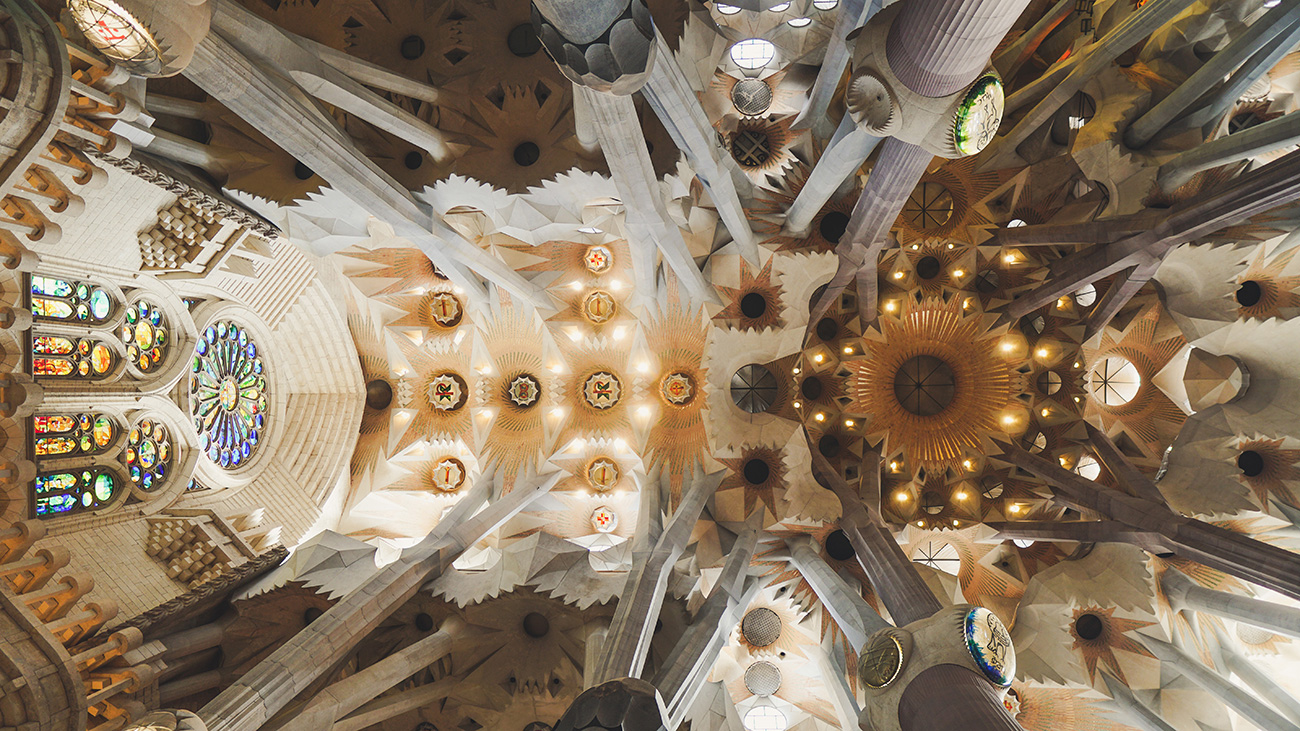
The Sagrada is oft cited as the oldest construction projection that's still ongoing. Work started on Antoni Gaudí's basilica in 1882, over 130 years after it's all the same unfinished. It was most recently slated for completion for 2026, although that looks set to be pushed dorsum again. When it'southward finally completed, the construction will have lasted only a few decades less than the Great Wall of China. Even in its unfinished land, it'due south a joy to behold thanks to its extravagant mix of architectural styles, near liquid-like spires, ornate facades, ornamental arches and vivid stained glass.
04. Notre Dame, Paris
The Notre Dame de Paris has long been one of the world's most celebrated cathedrals, and it's been even more in the spotlight since information technology was devastated by burn in April 2019. Nosotros've included it on our list to remember it in its full glory. Structure began on this cathedral in 1160, and the edifice has since had a brindled history of destruction and reconstruction. The French president Emmanuel Macron has said that the spire will be reconstructed exactly as it was, with up to 1,000 oak trees needed to make that happen.
05. Heydar Aliyev Center, Baku
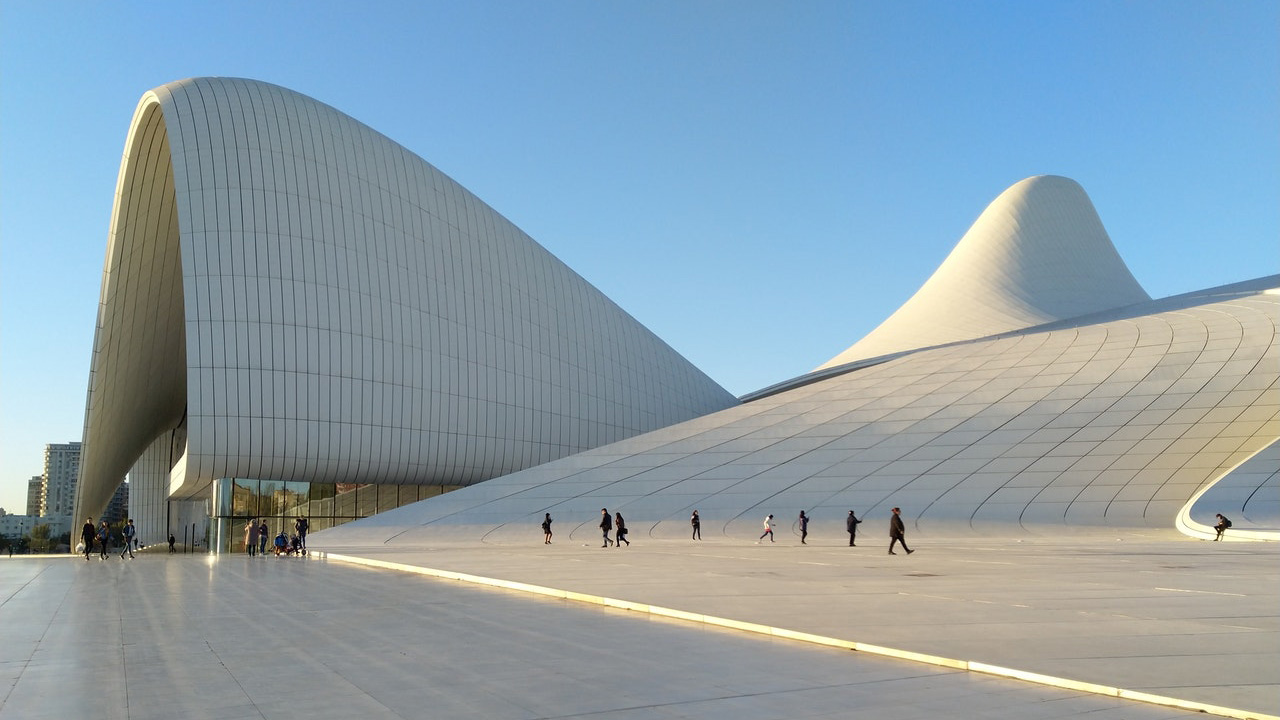
The Heydar Aliyev Center is 1 of the virtually famous buildings designed by the celebrated Iraqi-British architect Zaha Hadid. Located in Baku, Azerbaijan, it was completed in 2012 and was acclaimed for its distinctive flowing lines and lack of precipitous angles. Zaha Hadid Architects was awarded the commission post-obit a competition in 2007. On the firm's website, information technology explains the motivation behind the design: "The Center... breaks from the rigid and often awe-inspiring Soviet architecture that is then prevalent in Baku, aspiring instead to express the... optimism of a nation that looks to the future."
06. Cathedral of Brasilia, Brasilia
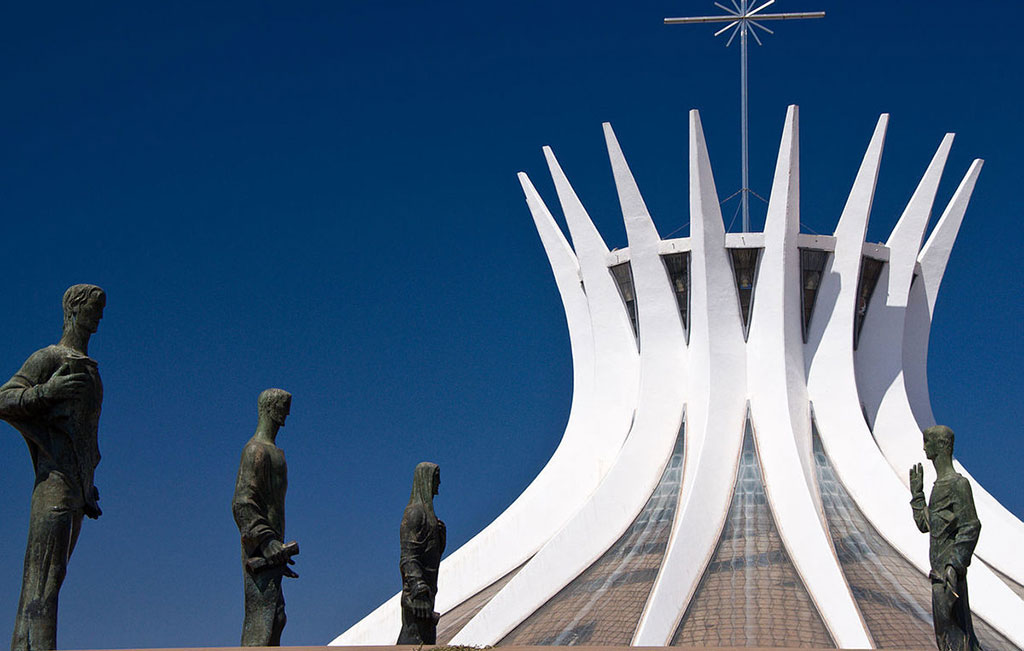
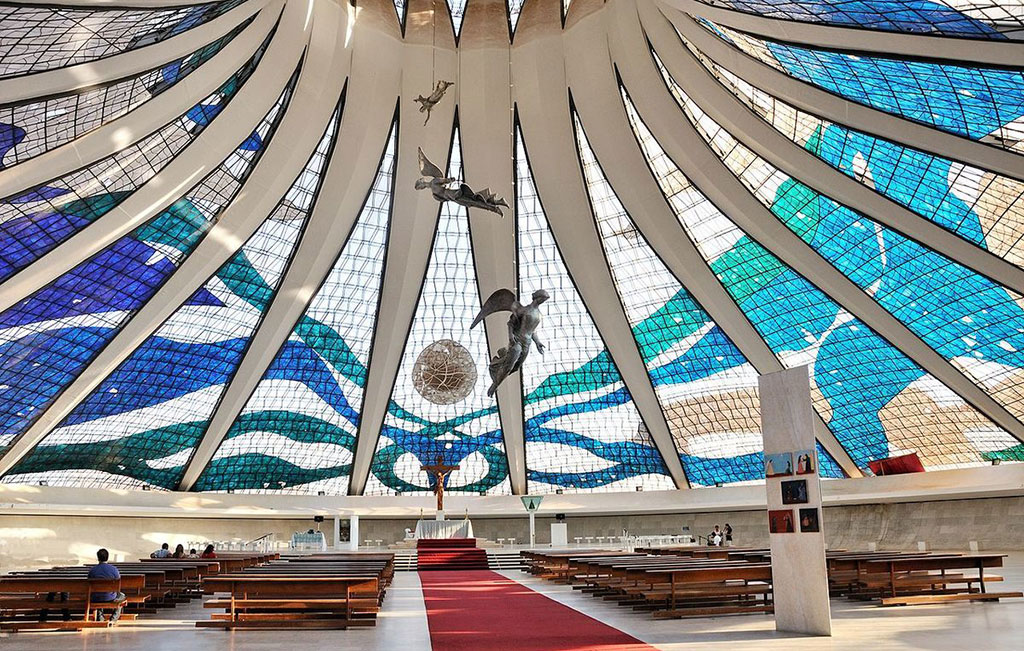
This curved beauty in the Brazilian capital, Brasilia, is just every bit hit inside as outside with its beautiful crown-like structure and stained glass. Information technology was created between 1958-1970 past Brazil'southward famed Oscar Niemeyer and Lúcio Costa. Interestingly because the religious context, both architects were actually communists. Their work rejects the trend for cube-like design that was favoured by their peers and celebrates the majesty of the bend.
07. Harpa Concert Hall, Reykjavik
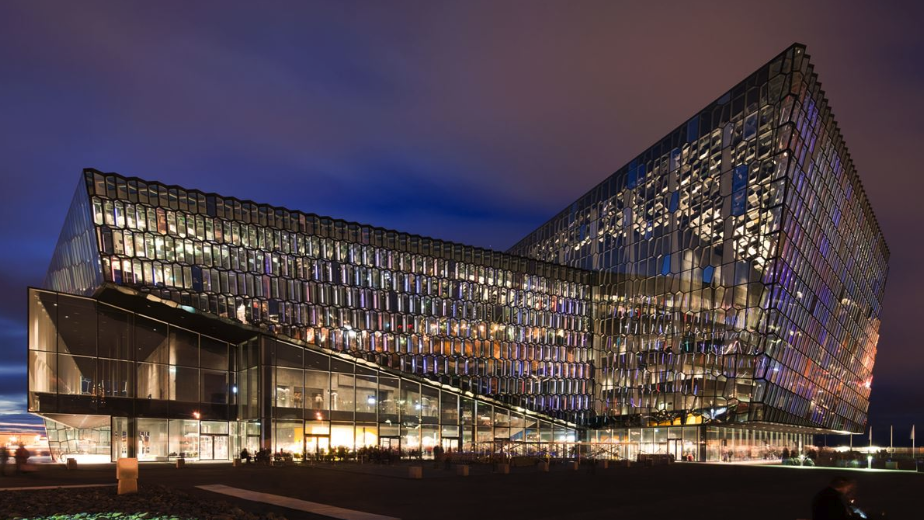
Harpa Concert Hall in Reykjavik was designed by Danish-Icelandic artist Olafur Elíasson alongside Henning Larsen Architects and Batteríið Architects. The kaleidoscope effect of the crystalline beat out deploys light and color in a way that plays with your senses when you lot enter the building. It looks like a shimmering sculpture that sits on the shoreline connecting the heaven and the body of water.
08. Milwaukee Fine art Museum, Wisconsin
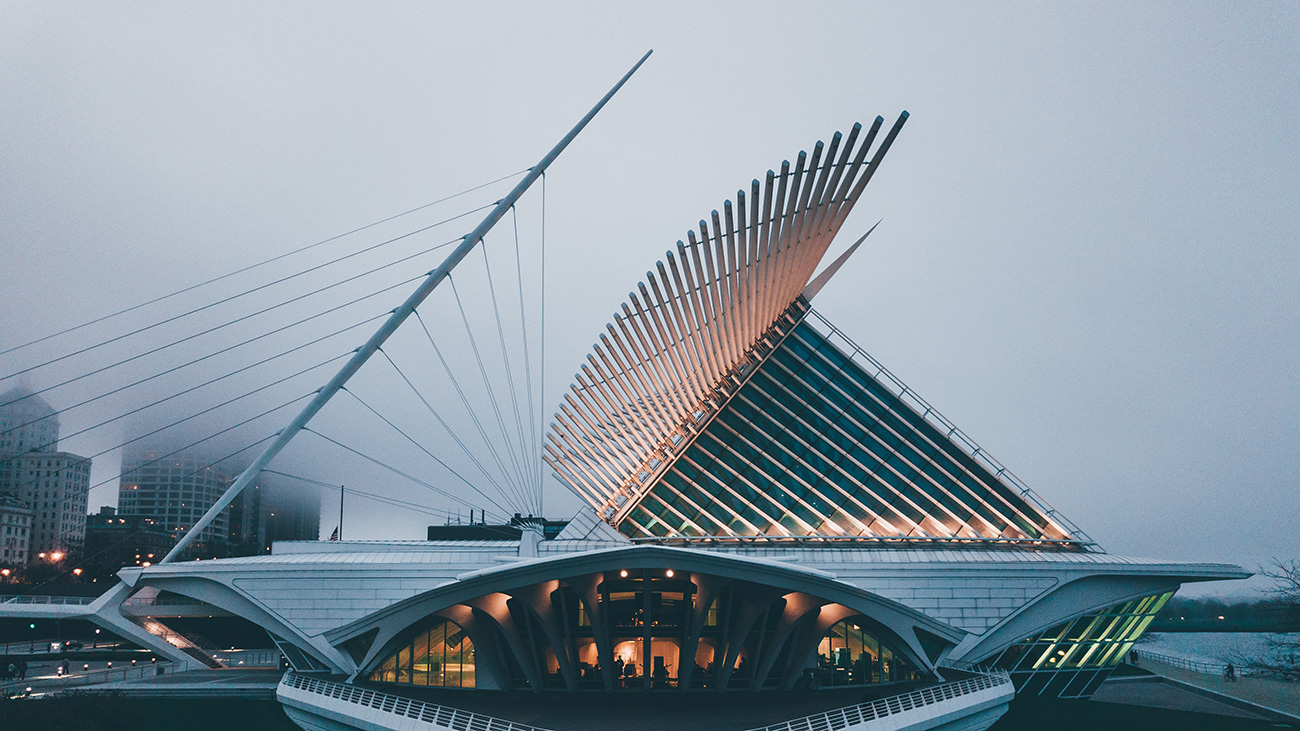

The Milwaukee Art Museum is an architectural landmark that comprises three separate buildings. The War Memorial Center (1957) was designed by Finnish-American architect Eero Saarinen; the Kahler Building (1975) past David Kahler; and the Quadracci Pavilion (2001) by Castilian architect Santiago Calatrava. The latter is an iconic sculptural edition typical of Calatrava'due south work with flying buttresses, pointed arches and ribbed vaults. Overlooking Lake Michigan, it's directly connected to Wisconsin Avenue by a cablevision-stay footbridge. Pedestrians tin cantankerous Lincoln Memorial Drive on the bridge and continue into the pavilion, while drivers enter via an undercover vaulted parking garage.
09. Forbidden Metropolis, Beijing
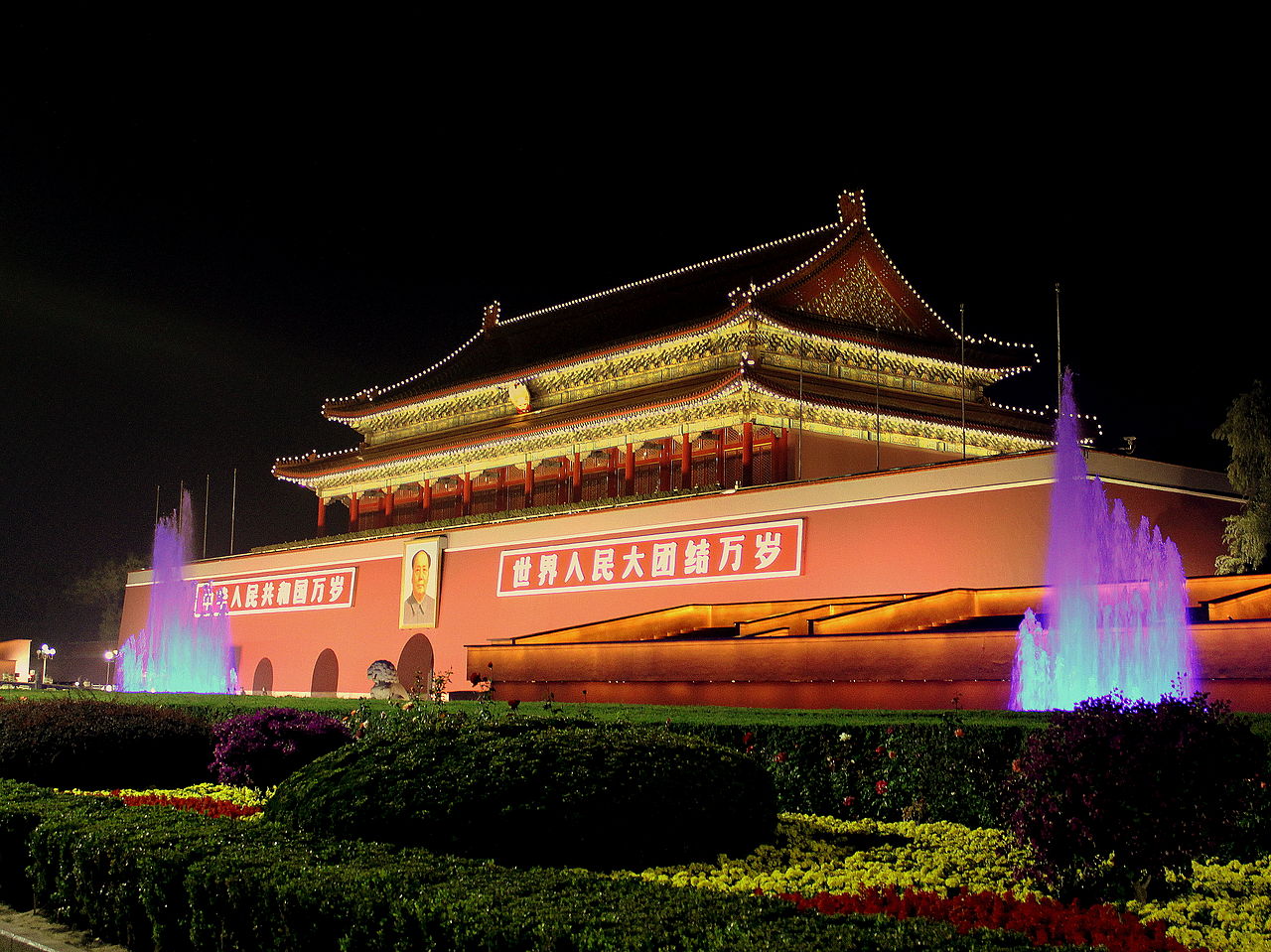
This is more than of a series of famous buildings than i – 980, to exist precise. Constructed betwixt 1406AD to 1420AD, the Forbidden City was dwelling to emperors from the fourth dimension of the Ming dynasty to the terminate of the Qing dynasty, making it the political center of China for half a millennium. Declared a UNESCO World Heritage Site in 1987, the old regal palace now houses the Palace Museum. It has the largest drove of preserved ancient wooden structures in the world and sees an average of 16 million visitors in a typical year – that's 40,000 visitors per day.
10. The Dancing Firm, Prague
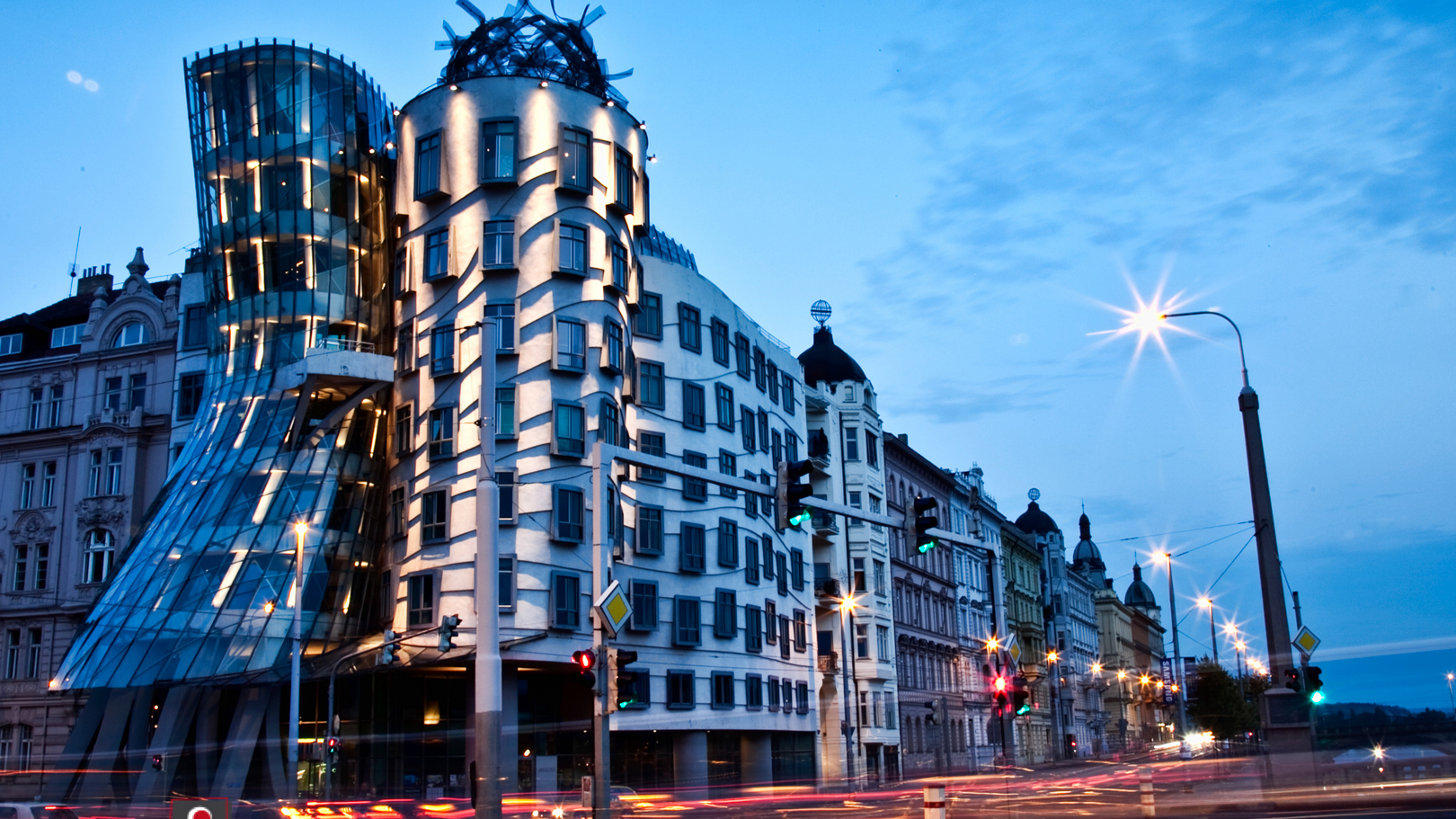
Dubbed The Dancing Business firm, Prague'south Nationale-Nederlanden building was designed by Croatian-Czech architect Vlado Milunić and Canadian-American architect Frank Gehry. The deconstructivist, or new-baroque, architecture forms the unusual dancing shape thank you to 99 concrete panels, each a different shape and dimension. The building's proved so popular that it now features on a golden ii,000 Czech koruna money issued by the Czech National Depository financial institution.
11. Bully Mosque of Djenné, Djenné
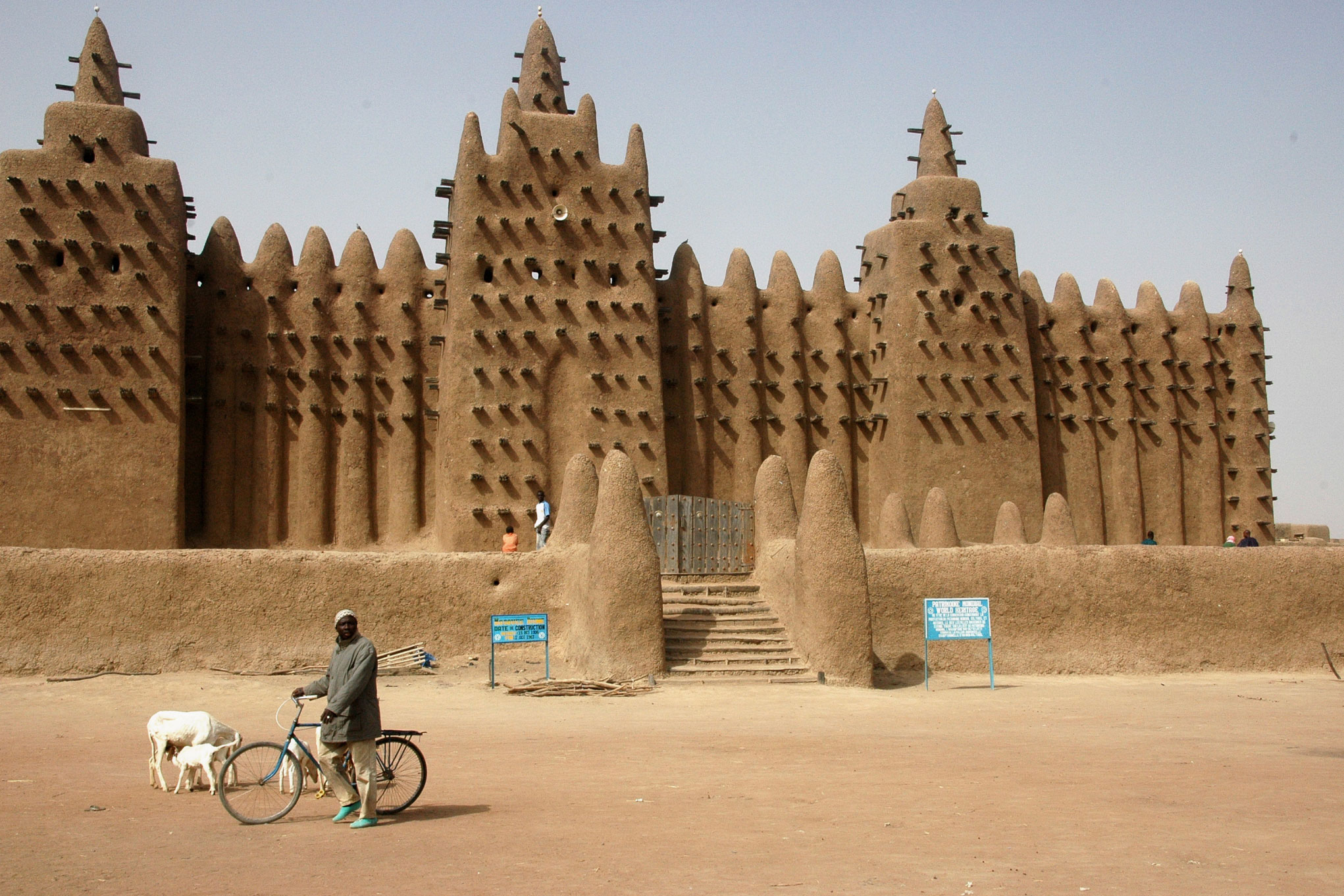
The Bully Mosque of Djenné in Republic of mali is i of the most famous buildings in Africa, and information technology's and then important in Mali that it features on the country's coat of arms. Information technology's made of world bricks that accept been dried in the sun, mortar made of sand and a plaster that creates a smooth surface.
Information technology is idea that a mosque has existed on the site since the 1200s. The current structure was rebuilt in 1907, and there'due south been some contend over whether or non the structure was influenced past French architecture (Republic of mali became independent from France in 1906). One time a yr, the people of Djenné have a festival and work together to complete whatsoever necessary repairs.
12. Lotus Temple, New Dehli

The Lotus Temple is a Bahá'í House of Worship in New Delhi. It comprises 27 structures resembling lotus petals, which open onto a primal hall that's effectually 40m loftier. The surface of the structure is fabricated of white marble from Mount Pentelicus in Greece, the same marble used to build the Parthenon. The building has ix sides, ix doors, and can adapt 2,500 people. Since its completion in 1986, it's become i of the virtually visited buildings in the world, attracting over 100 million people.
13. Himeji Castle, Himeji
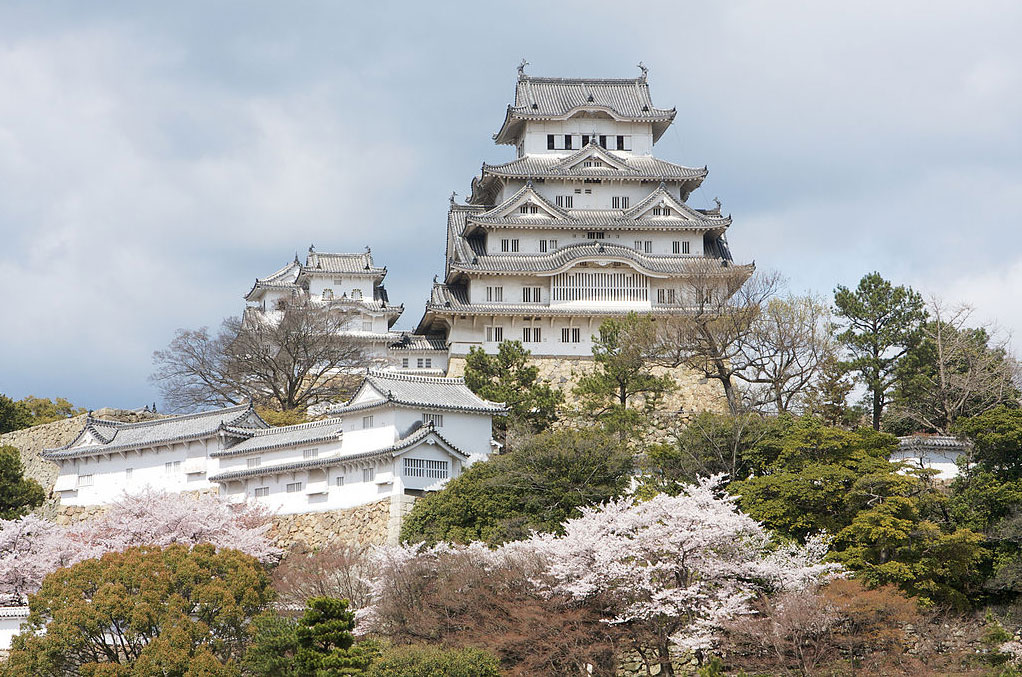
Himeji Castle is a spectacular Japanese castle almost Kyoto. Information technology's over 400 years erstwhile and in pristine conditions having escaped harm by state of war or natural disasters. The whole circuitous is made upwardly of over 80 buildings, which are connected together past gates and winding paths. A marvel to behold, it'southward often dubbed the White Egret or White Heron Castle because of its white elegant exterior, which is said to resemble a bird taking flight.
14. Cologne Cathedral, Cologne

Cologne Cathedral is a Loftier Gothic five-aisled cathedral. Construction began in 1248 and went on until it was halted in 1473 before the edifice was complete. Work didn't resume until the 1800s, and the cathedral was finally finished in 1880. Later on work follows the original medieval plan faithfully and the building is renowned as a Gothic masterpiece. Information technology likewise houses many works of fine art too as the Shrine of the 3 Kings, which is traditionally believed to hold the remains of the biblical Three Kings.
xv. Dome of the Rock, Jerusalem
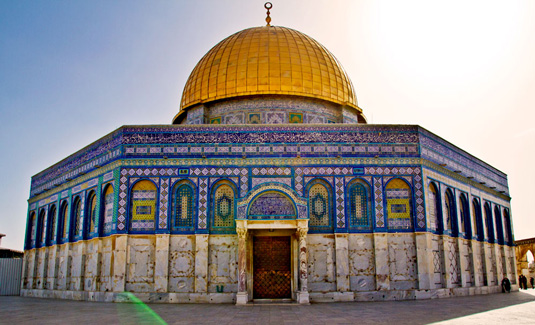
A masterpiece of Islamic compages, the Dome of the Rock in Jerusalem was built by Caliph Abd al-Malik betwixt 687 and 691. The octagonal programme and the woods rotunda dome are of Byzantine design. The Farsi tiles on the exterior were added past Suleiman I in 1561, and the interior decoration was later added to with marble, mosaic and faience. The oldest extant Islamic monument, the Dome of the Rock has served as a model for compages and other art for more than a millennium.
16. La Pedrera, Barcelona

There are several unusual, beautiful buildings from the architect Antoni Gaudí nestled in the urban streets of Barcelona. His unique arroyo to the Art Nouveau movement generated some of the most creative buildings the world has seen, and La Pedrera is no exception. One of the nigh imaginative houses in the history of architecture, it'due south more than of a sculpture than a building. The façade is a varied but harmonious mass of undulating stone that, along with its forged fe balconies, explores the irregularities of the natural world. The United nations Educational, Scientific and Cultural Organization (UNESCO) granted it World Heritage status in 1984.
17. St Paul'south Cathedral, London

Designed by English architect Sir Christopher Wren, St Paul'due south Cathedral is i of London'due south most iconic buildings. Sitting at the top of Ludgate Hill, the highest point in the Urban center of London, its famous dome is one of the world'due south largest, measuring nearly 112 metres high.
The original church on the site was founded in 604AD, and work on the nowadays English Bizarre church began in the 17th Century equally role of a major rebuilding programme after the Great Fire of London. Wren started working on his designs in 1666 and took ix years to consummate them. The actual structure took a farther 35 years. St Paul's has played an integral function of London life ever since, as a dominant part of the skyline and a centre for tourism, religious worship and anticapitalist protests. See our designer's guide to London for more highlights of the UK capital letter.
18. Petronas Towers, Kuala Lumpur

Standing at 451.9 metres alpine, these linked twin skyscrapers are an iconic landmark in Kuala Lumpur, Malaysia. The Petronas Towers held the title of tallest building in the world between 1998-2004. The distinctive postmodern fashion was created by architects Cesar Pelli and Achmad Murdijat, engineer Disk Cerico and designer Dominic Saibo under the consultancy of JC Guinto. The design of each flooring plate was based on the simple Islamic geometric forms of ii interlocking squares, creating the shape of an eight-pointed star.
19. The White Firm, Washington
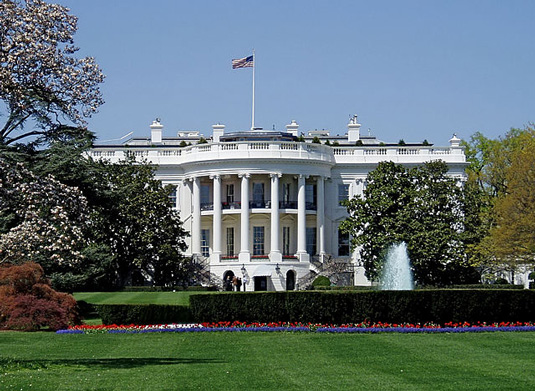
The White Firm, perhaps the globe's most famous political residence, was designed by Irish gaelic builder James Hoban. He submitted a plan for the presidential mansion in 1792 and subsequently won the commission to build the White House. Construction began in 1793 and was completed in 1801. The mansion, which has been home to every US leader since the country'due south 2d president John Adams, is made from white-painted Aquia sandstone.
xx. Leaning Belfry of Pisa, Pisa
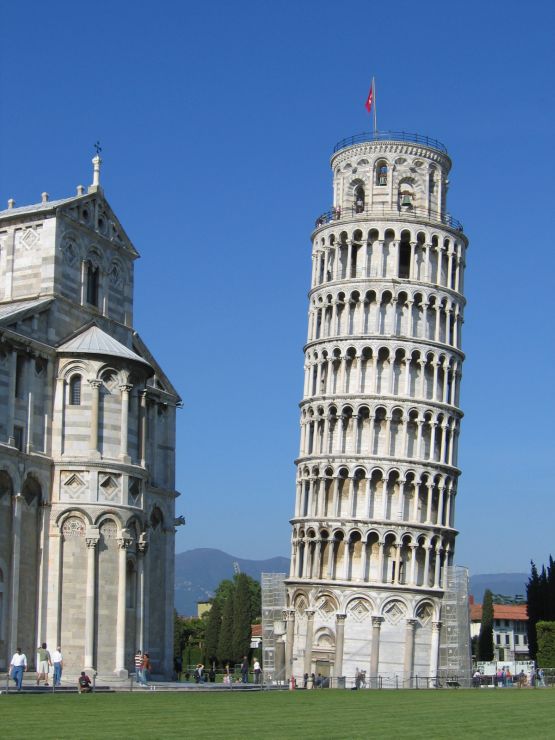
The Leaning Tower of Pisa is one of the most remarkable architectural structures in Europe, all-time known for its adventitious tilt. The belfry began to lean during construction because soft basis on one side was unable to properly support the structure's weight. Building work began in 1173 and went on for a staggering 199 years. In that location'south been much controversy as to the true identity of the architect behind information technology. The blueprint was originally attributed to the creative person Bonnano Pisano, but studies have likewise implicated architect Diotisalvi.
21. The Kaaba, Mecca

The Kaaba, significant cube in Standard arabic, is a square building located in Mecca, Kingdom of saudi arabia. An important sacred site in Islam, the Kabba is elegantly draped in a silk and cotton fiber veil. Every year millions of Muslims travel to visit it for the hajj, the Islamic pilgrimage to Mecca. The pocket-size foursquare building is about 45 anxiety high and its walls are a metre wide, with its total size occupying roughly 627 square feet.
22. The Shard, London
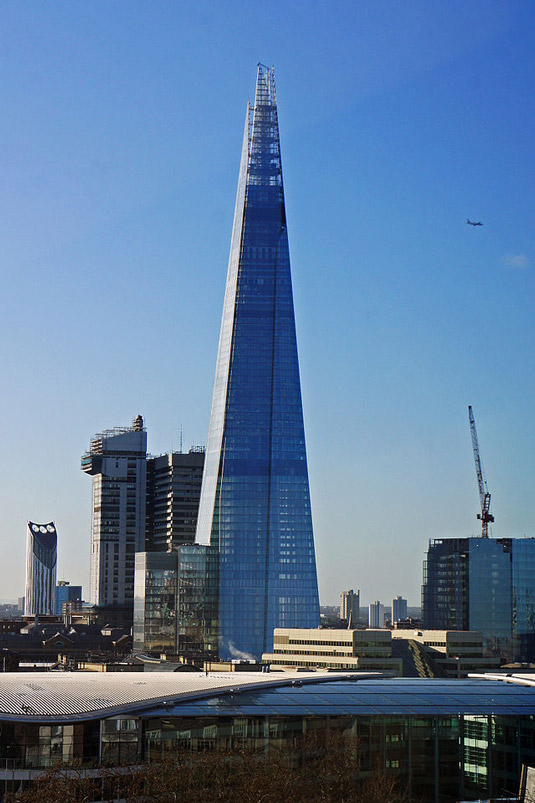
Likewise referred to as the shard of drinking glass, The Shard is the tallest building in Western Europe and the second tallest costless-standing structure in the Uk behind
the Arqiva radio and television receiver belfry in W Yorkshire. The 95-storey skyscraper was designed by builder Renzo Piano. It'due south outside boasts eleven,000 drinking glass panels – equivalent in area to eight Wembley football pitches or two-and-a-half Trafalgar Squares.
The building was developed to have multiple uses, being described on the website equally a 'vertical city where people tin alive, work and relax', a motto that was taken on lath by a fox, nicknamed Romeo, that was constitute on the 72nd floor towards the terminate of construction. Piece of work began in 2009 and finished in 2012.
23. Las Lajas Sanctuary, Nariño
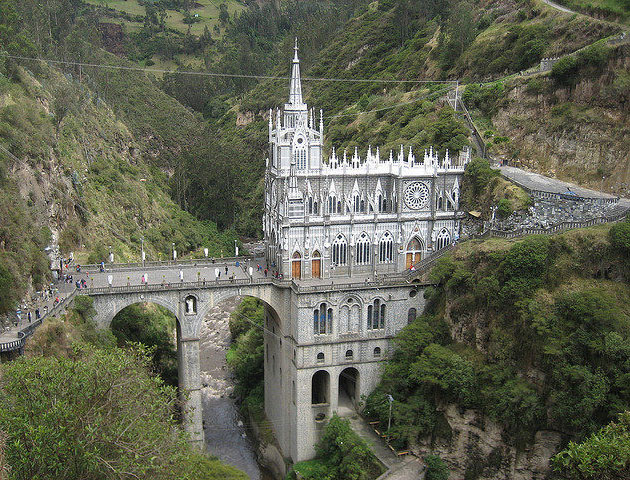
This dramatically situated church building in Southern Colombia crosses a canyon. If that isn't impressive, we don't know what is. Why here? Because it's the site where a woman and her daughter reportedly saw an apparition of the Virgin Mary in 1754, afterward which the previously deaf and mute daughter was able to speak. Since then, various shrines take been built. The current gothic-looking construction was created between 1916-1949.
24. St Basil'southward Cathedral, Moscow
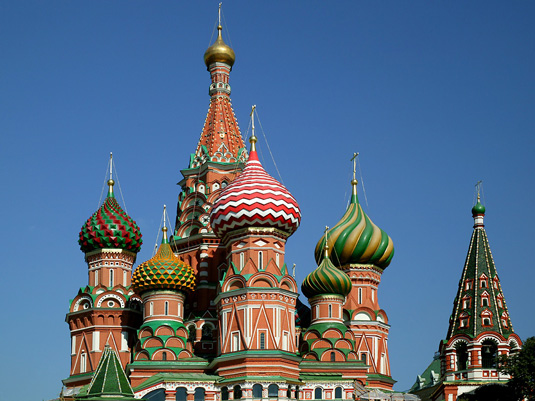
No, not Disneyland. This extravagant candy-coloured cathedral is Moscow's about famous building, and most visited tourist attraction. Shaped to resemble the flame of a bonfire ascent into the sky, St Basil's Cathedral is located only outside the Kremlin gates, marker the centre of Moscow. Built between 1555 and 1561, it was erected during the reign of Ivan 4 (Ivan the Terrible). Trivial is known about the building's architect Postnik Yakovlev, merely he was clearly a fan of onion domes, abrupt spikes and polygonal towers.
25. Empire State Building, New York

We couldn't put together a list of earth-famous buildings without including this grand Art Deco skyscraper. Once the tallest edifice in the earth, the Empire State was congenital in but 410 days, with work starting on St Patrick'southward Day 1930. The building was designed past William F Lamb of architectural firm Shreve, Lamb and Harmon. It was alleged past the American Society of Civil Engineers to be one of the Seven Wonders of the Modern World and is known as an icon of New York City.
26. Lloyd's Edifice, London

The accolade-winning Lloyd's building (as well known as the Inside-Out building) looks like information technology belongs in a sci-fi motion-picture show rather than London'south Lime Street. The futuristic architectural landmark is one of the nigh recognisable constructions on the London skyline. Architects Roger Stirk Harbour + Partners were backside the innovative design, which put utilitarian elements like h2o pipes and staircases on the outside. Built betwixt 1978 and 1986, the building also features 12 exterior lifts, which were the kickoff of their kind in the U.k..
27. The Colosseum, Rome

This elliptical amphitheatre in the middle of the Italian capital is considered 1 of the greatest architectural feats of Ancient Rome. The stadium could seat at least l,000 spectators, mainly for gladiatorial games. Built mainly using concrete and stone between around 72AD and 80AD, the design and shape of the Colosseum has inspired many modernistic-day stadiums. Today it is one of Rome's most popular tourist attractions, alluring thousands of visitors each year.
28. Taj Mahal, Agra

Recognised as 'the jewel of Muslim art in Bharat', the Taj Mahal was congenital by the Mughal emperor Shah Jahan. Oft mistaken as a palace, this famous landmark was actually congenital as a tomb for the emperor's married woman afterwards she died giving birth to their 14th child. It's regarded as one of the finest examples of Mughal architecture – an affiliation of Persian, Turkish and Indian styles. Structure began in 1632 and was completed in 1643. The surrounding buildings and gardens took around five more years to cease.
29. Chrysler Building, New York

In the early on part of the 20th Century, there was a race to build the tallest building. At the fourth dimension, this gorgeous Art Deco skyscraper was well-nigh outdone by the Bank of Manhattan, but its spire (which was constructed in secret) enabled it to take the title of 'tallest building in the earth' in 1930. That didn't terminal long though. Less than a year later on, the Empire Country Edifice stole its crown. Designed past architect William Van Alen, the skyscraper was commissioned by car manufacturer Walter P Chrysler, hence its name.
30. Sydney Opera House, Sydney
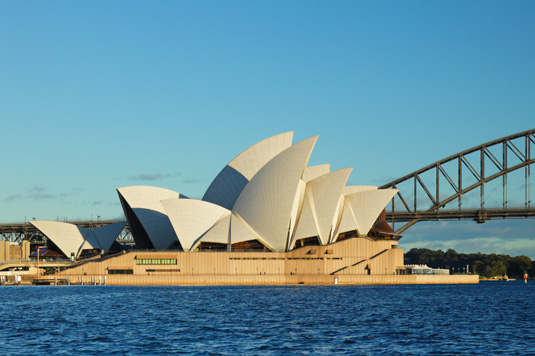
The Sydney Opera Business firm is widely regarded as 1 of the greatest architectural works of the 20th century. The innovative pattern came from architect Jørn Utzon, who was relatively unknown until January 29, 1957 when his entry won the international competition to design a national opera firm at Bennelong Bespeak, Sydney. The beautiful building comprises three groups of interlocking shells, which cover two principal functioning halls and a restaurant. A masterpiece of modernistic architecture, the opera house has go an iconic symbol of both Sydney and Commonwealth of australia as a whole.
31. Space Needle, Seattle

A collaborative endeavor between architects Edward Eastward Carlson and John Graham, the futuristic Space Needle in Seattle, Washington was built for the 1962 World'south off-white. The famous landmark stands at 184m high and 42m broad at its widest bespeak. Not simply is the compages a marvel to look at but it'south a feat of engineering too, congenital to survive wind speeds of 200mph and earthquakes of upward to ix.1 in magnitude.
32. Hagia Sophia, Istanbul
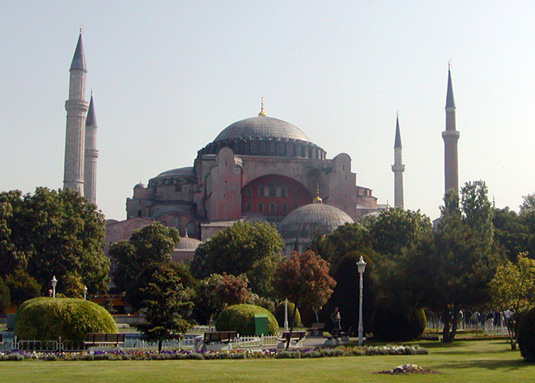
Once a church, after a mosque and now a museum, Hagia Sophia is a perfect example of Byzantine compages. Located in Istanbul, Turkey, the edifice was originally constructed between 532AD and 537AD. It'due south been rebuilt many times since and so, due to a range of factors, including earthquakes and beingness burned down in riots. Despite this, Hagia Sophia is widely recognised as ane of the most impressive buildings in the world. Information technology also featured in the opening scenes of the James Bail picture, Skyfall.
33. Buckingham Palace, London

Originally known as Buckingham Business firm, the royal palace was bought by George Iii in 1735 when the mansion was trivial more a cherry brick business firm. Since then, various architects have worked on the building to make it what information technology is today, including John Nash and Edmund Blore. The exterior in Bath stone was designed in a Neo-classical French style. The East face up of the palace was refaced in Portland stone in 1913. The palace had to undergo all-encompassing work after being bombed no less than 9 times during Globe War 2. Despite that, it's nonetheless a working royal residence.
34. Fallingwater, Pennsylvania
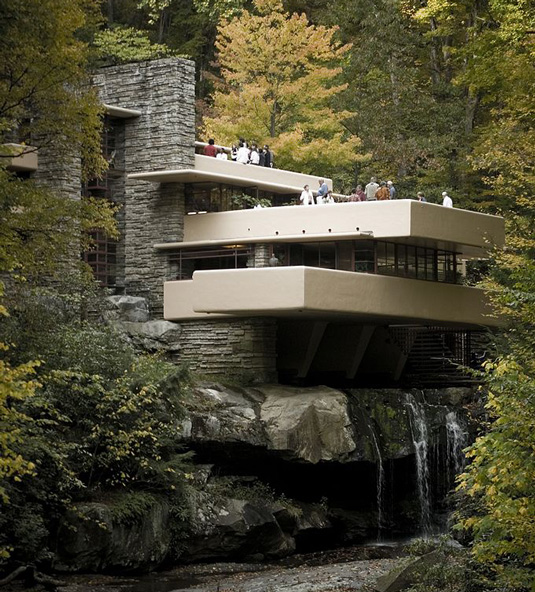
Designed by famous American builder Frank Lloyd Wright in 1934, Fallingwater is possibly the most famous private residence in the world. Why? Well, the unique design makes information technology expect like the business firm stretches out over a 30ft waterfall, with no solid ground beneath it. This evidently isn't the example, but the innovative blueprint captured the world'southward attending when it was completed in 1939. Information technology became famous instantly and is now a celebrated landmark. Information technology's so cool that you can even get a Lego version.
35. Pantheon, Rome

Rome is home to many incredible famous buildings, and the Pantheon is no exception. Like the urban center itself, it wasn't built in a day. Destroyed and then rebuilt twice, the building began as a rectangular structure before evolving into the gorgeous domed building seen today. An inspiration to architects all over the world, the Pantheon's roof remains the earth's largest unreinforced concrete dome. There is much debate between historians over which emperor and architects were responsible for the design, only we know that the 'Temple of the Gods' was first congenital in around 126AD.
36. Burj Khalifa, Dubai

Last on our list – but by no ways the least – is the world'southward tallest building, Burj Khalifa. This towering skyscraper and centrepiece of downtown Dubai stands at an incredible 828.9 metres loftier. Structure on the 160-flooring building began in 2004, and its doors opened six years later in 2010. It was designed by the Chicago role of American architectural and engineering house Skidmore, Owings and Merril LLP. A Y-shaped tripartite flooring was used to optimise residential and hotel space, while a buttressed fundamental core and wings support the stunning height of the building.
Related manufactures:
- Best Nikon photographic camera: Top Nikon cameras for everyone
- Photography skills: Vivid tips to improve your skills
- Pencil drawing techniques: Pro tips to sharpen your skills
Related articles
montanezdient1993.blogspot.com
Source: https://www.creativebloq.com/architecture/famous-buildings-around-world-10121105
0 Response to "Archtiecture Is When a Building Looks Better Than the Art Inside"
Post a Comment